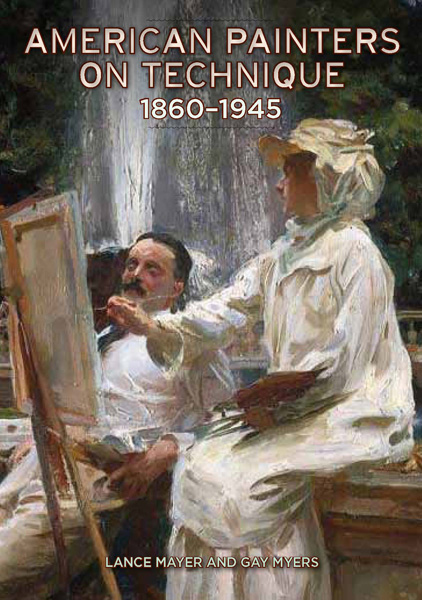FEATURE BY Willard Manus
In their new book, AMERICAN PAINTERS ON TECHNIQUE, the art researchers and conservators Lance Mayer and Gay Myers concentrate on some of the little known aspects of the history of American art, circa 1860-1945.
“This
volume is based primarily on firsthand descriptions of materials and techniques
that we have compiled over the last twenty-five years from artists’
notebooks, painting manuals, magazines, suppliers’ catalogues, letters
diaries and interviews,” the authors write.

“In the first part of our story, the predominant theme is the increased numbers of Americans who traveled to various parts of Europe for instruction, resulting in an explosion of transplanted techniques. Americans took what they had learned in Dusseldorf, Paris, Munich, or the Netherlands and recombined those lessons, sometimes in unique ways, as they developed their own styles. This led to techniques that were varied in the extreme. Some painters were cautious about adding medium to their paint, while others painted ‘in a puddle of oil.’ Some Americans who fell under the influence of French Impressionists began to paint more thickly and opaquely, and with brighter colors than before, while Tonalists influenced by Whistler and the Barbizon and Hague schools often used thin glazes and preferred muted colors. Some artists applied glossy varnishes, while others objected vociferously to varnishing. The polarization and name-calling that grew out of these differences resulted in dialogues that often shed additional light on artists’ methods.”
Among the artists who are examined here are William Page (an “American Titian”), George Innes, James McNeill and John Singer Sargent. The latter, it turns out, “took great pains to arrive at results that appeared fresh and unstudied. And in his murals and watercolors (as opposed to his easel paintings) he sometimes did use materials and techniques that could be considered unusual or innovative in order to achieve special effects.” Ultimately, though, his greatness was not achieved through the application of technical tricks but through “the great skill with which he used ordinary materials and above all in his willingness to efface and redo his previous efforts.”
AMERICAN PAINTERS ON TECHNIQUE is aimed mostly at curators, art historians, painters and conservators–but it’s safe to say that anyone who loves art will learn much from this informative and fascinating book.
(Getty Publications, 276 pages, hardcover; 20 color illustrations. $50.00. Getty.edu/publications or 800-223-3431)
